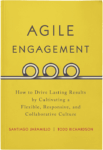 Agile Engagement: How to Drive Lasting Results by Cultivating a Flexible, Responsive, and Collaborative Culture
Agile Engagement: How to Drive Lasting Results by Cultivating a Flexible, Responsive, and Collaborative Culture
by Santiago Jaramillo and Todd Richardson was released on December 5, 2016. This book focuses on how businesses can transform culture and engagement in their organizations by applying the proven principles of agile software development to the world of employee engagement.1
Here are some of my key takeaways from the book:
Defining Employee Engagement
“But it has also been proven that positive cultures and high levels of employee engagement drive tangible bottom-line benefits. An engaged workforce helps boost profits, increase employee loyalty and tenure, and heighten customer satisfaction.”2
“We define employee engagement as an employee’s emotional and intellectual connection with an employer, as demonstrated by his or her motivation and commitment to positively impact the company’s vision and goals.”3
“Not surprisingly, countless elements can impact positive or negative employee engagement, but we consider the most potent to be the following: Strategic Alignment. Employees can both verbalize and actualize the core business strategies. Understanding of Success. Employees understand their organizational, departmental, and personal success metrics and tangibly grasp their contribution to the company’s overall success. Clear Communication. Employees trust the company because of coherent and frequent contact, timely feedback, and clear expectations. Workplace Vibe. The overall environment fosters effective work in everything from the physical workspace to interactions between employees. Growth Paths. Employees have the opportunity to grow their skills through new work challenges and positions over time, in both managerial and independent contributor roles.”4
Defining Workplace Culture
“We define workplace culture as the customs, social expectations, and attitudes formed around work and personal interactions in the work environment.”5
Happiness Versus Engagement
“Ultimately, engagement is about knowing the organization’s purpose and our purpose within it, having the tools to perform at our best, and having passion to contribute to our full potential. It is about maximizing strengths, making meaningful contributions, and feeling valued.”6
“Luckily for employers, both meaning and engagement are surprisingly malleable through our habits, interactions with coworkers, and overall perspective (Achor, 2012). Each of these five simple, quick hacks, every day for 21 days, is enough to elicit statistically significant changes. Write down three things for which you are grateful. Write a positive message to someone in your social support network. Meditate at your desk for 2 minutes. Exercise for 10 minutes. Take 2 minutes to reflect on the most meaningful experience of the past 24 hours.”7
Work Expectations
“As humans, we are naturally drawn to challenging ourselves in the hopes of achieving a sense of progress, accomplishment, and self-worth.”8
Willingness to Be Wrong and the Humility to Learn
“There are many hazardous side effects of cultures in which people are afraid to voice doubt or dissent. Management consultant Margaret Heffernan expands on one that she dubs willful blindness. In studies of corporations across the United States and Europe, she found that 85 percent of people said there were questions or issues at work they were afraid to raise—they recognize that there is a problem, but they neglect to say anything about it. She found that the numbers remain consistent across countries and demographics, and that under certain circumstances we are all guilty of and prone to being willfully blind (Heffernan, 2014).”9
“The real danger in organizations, she poses, is silence, with “all those brains whizzing around full of observations and insight and ideas that are not being articulated” (Heffernan, 2014).”10
Potential Solutions
“We seem to have reached our brink of information and work overload, and now we are entering an era of “doing less better” rather than “doing more with less.” Instead of continuing to work more, we are learning to improve the work process itself.”11
The War for Talent
“The World Economic Forum states that talent, not financial capital, is the “key to innovation, competitiveness, and growth in the 21st century” (Jackson, 2015).”12
HR Leaders
“How to get talented people, how to keep them, and how to motivate them to do their best work, not to mention being responsible for a huge portion of workplace costs (70 percent of an average company’s expenses) (The Changing Role of the CHRO).”13
Engagement Canvas and Emplify Score Overview
“According to Deloitte’s 2015 report (Global Human Capital Trends 2015, 35): A significant 87 percent of organizations worldwide cite culture and engagement as a top business challenge. Only 7 percent rate themselves as “excellent” at measuring, improving, and driving engagement. Only 12 percent rate themselves as “excellent” at effectively driving the desired culture. Only 22 percent of organizations report that they have either a poor program for measuring and improving engagement, or no program at all.”14
Subcultures Bind People to the Organization
“Although the number 150 gets all the fame, Dunbar actually coined a series of numbers, decreasing from 150 to 50, our close friends; then to 15, our confidants; and finally to our closest support group of 5 (Discreet Hierarchical Organization of Social Group Sizes, 2005). On the flipside, our groups expand from 150 to 500, our acquaintances; and then to 1,500, our limit of people for whom we can put a name to a face.”15
Intuitions Come First; Reasoning Comes Second
“Before people decide what they think of your message, they decide what they think of you. Trust and cooperation are not instructions; they’re feelings.”16
What Happens Between Two Brains When They Interact
“When we interact with people, our brains make snap judgments about them. Harvard Business School psychologist Amy Cuddy has found that we primarily gauge two characteristics: how lovable they are (warmth, communion, trustworthiness) and how fearsome they are (competence, strength, agency). With these two dimensions of social judgment, we answer two critical questions: “What are this person’s intentions toward me?” and “Is he or she capable of acting on those intentions?””17
About These Key Takeaways
Building and maintaining a winning culture and engaged employees takes time. While my key takeaways were highlighted, I invite you to read the book and determine your key takeaways. For instance, the Engagement Canvas was not covered in my recap and I encourage you to learn more about it and potentially join the Engagement Canvas Community.
1 Jaramillo, Santiago, and Todd Richardson. Agile engagement: how to drive lasting results by cultivating a flexible, responsive, and collaborative culture. Hoboken, NJ: John Wiley & Sons, Inc., 2016. Print., pg. xii.
2 Ibid., pg 3.
3 Ibid., pg 4.
4 Ibid.
5 Ibid., pg 5.
6 Ibid., pg 10.
7 Ibid., pg 11.
8 Ibid., pg 67.
9 Ibid., pg 78.
10 Ibid.
11 Ibid., pg 101.
12 Ibid., pg 113.
13 Ibid., pg 114.
14 Ibid., pg 119.
15 Ibid., pg 200.
16 Ibid., pg 208.
17 Ibid.
Which of the takeaways above resonated with you? What key takeaways would you have included?
Let’s Engage!
I’m Agent in Engagement Simpson…Gregory F Simpson.
Employee engagement is a critical mission. I hope I can count on your help! Subscribe to the RSS Feed to receive the latest intelligence/insights and/or register to make entries in the comments log.
 You can follow me @agtinengagement.
You can follow me @agtinengagement.
Email me at g…@a…t.com.
Connect via LinkedIn at LinkedIn.com/in/GregoryFSimpson.
Learn more about me at gregoryfsimpson.com.
P.S. First contact? Welcome to the Agent In Engagement community. Explore and join fellow employee engagement operatives in targeting a known thief – alias: Disengagement. Together we can bring this thief to justice and make the world a better place for all companies and their employees.
Other recent Agent in Engagement data/reports by Agent Gregory F Simpson:
- Employee Engagement Intelligence Briefing: 2017.05.01 – 2017.05.05
- Veteran Operative Employee Engagement Insights: 05.01 – 2017.05.05
- May the 4th Be With You!
- Employee Engagement-Related Spotlight Articles of April 2017
- Employee Engagement In the News: It’s No Fairytale
- Employee Engagement-Related Spotlight Articles of March 2017
- In Haiku Poems, Like Employee Engagement, Shared Experience